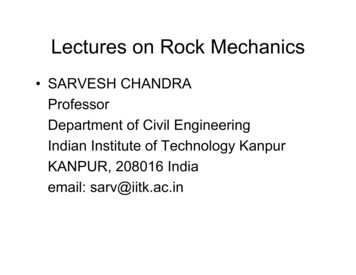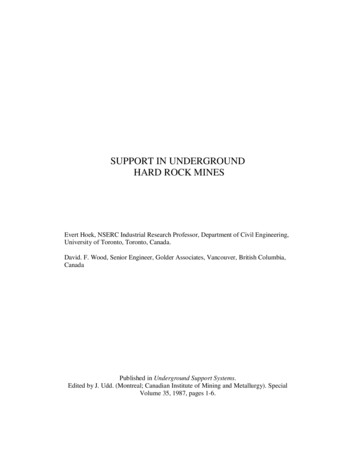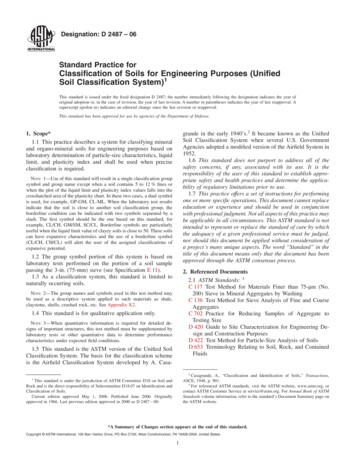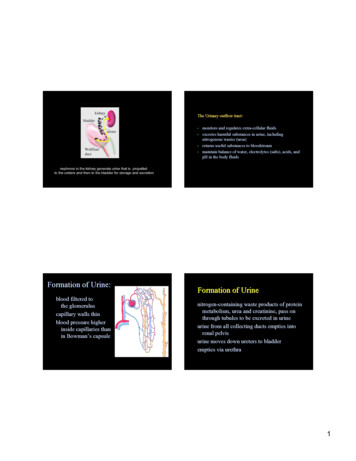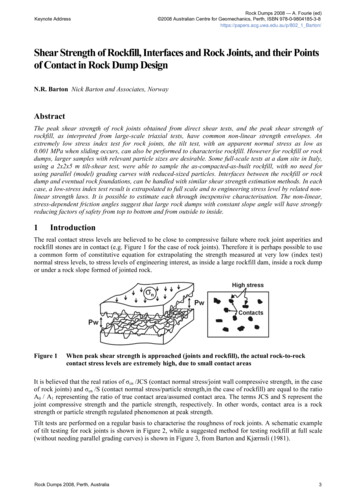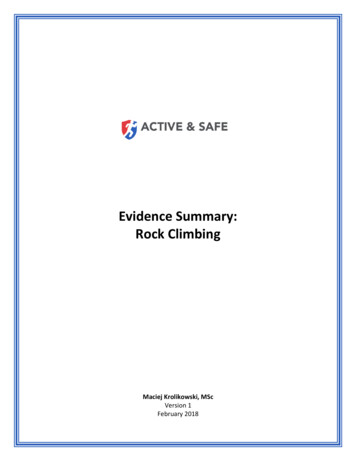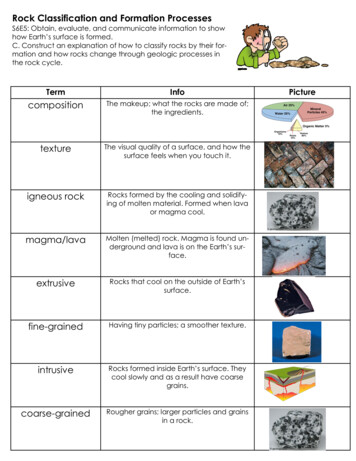
Transcription
Rock Classification and Formation ProcessesS6E5: Obtain, evaluate, and communicate information to showhow Earth’s surface is formed.C. Construct an explanation of how to classify rocks by their formation and how rocks change through geologic processes inthe rock cycle.TermInfocompositionThe makeup; what the rocks are made of;the ingredients.textureThe visual quality of a surface, and how thesurface feels when you touch it.igneous rockRocks formed by the cooling and solidifying of molten material. Formed when lavaor magma cool.magma/lavaMolten (melted) rock. Magma is found underground and lava is on the Earth’s surface.extrusiveRocks that cool on the outside of Earth’ssurface.fine-grainedHaving tiny particles; a smoother texture.intrusiveRocks formed inside Earth’s surface. Theycool slowly and as a result have coarsegrains.coarse-grainedRougher grains; larger particles and grainsin a rock.Picture
TermInfocoarse-grainedRougher grains; larger particles andgrains in a rock.sedimentary rockRock that is formed when sediment isdeposited, and pressed together overtime to form rock.sedimentsLoose material made of rockfragments, chemical particles andsalts, mineral fragments.compactionProcess where sediments are deeplyburied, placing them under pressurebecause of the weight of other layers.cementationWhen the sediments get GLUEDtogether. Cement natural glue.weatheringDestructive processes that break largerocks down into smaller rocks andsediments.erosionWearing away of rock or other solidmaterials by wind, water, glacialactivity, etc.depositionWhen sediments are dropped off andpiled up by means of erosion.metamorphic rockRock that forms when existing rocksuch as igneous and sedimentary aresubjected to extreme heat andpressure.Picture
TermInfoNon-foliatedMetamorphic rocks that aresubjected to equal pressure fromall sides and do not have a striped/layered appearance.foliatedMetamorphic rocks that havemore pressure in one direction,which causes sheets and layers;visible striped appearance.fossilThe preserved remains of ananimal or plant from long ago; thetissues have been replaced byminerals.rock cycleCycle of processes that rocksundergo when they change fromone type of rock to another.heat and pressureHigh temperature and highpressure inside Earth cause rocks tobecome metamorphic rocks.graniteLight-colored intrusive igneous rockwith large crystals that are visible tothe naked eye.basaltCommonly an extrusive igneousrock that is dark in color, has finegrains.PaleontologyThe branch of science that studiesfossils.ClasticSedimentary rocks composed ofbroken pieces of older rocks. Looklike a bunch of rock chunks gluedtogether.Picture
TermInfoChemicalsedimentarySedimentary rocks that form whenminerals dissolved in waterbecome solid.Organic sedimentarySedimentary rocks that includeorganic matter and fossils.ExtinctA species that does not have anyliving members.Uplift (force)Process by which Earth’s crustslowly rises.PictureLearning Targets:1. I can describe 3 things are used to classify/identify a rock and apply thisknowledge by correctly identifying rocks.2. I can explain how minerals (elements or compounds) make up rocks.3. I can describe rocks as mixtures of minerals and explain how some rocks may contain organicmatter.4. I can classify the 3 types of rocks and describe HOW they form.5. I can describe the process of formation of metamorphic rocks pressure and relate the heat andpressure to crystal formation.6. I can differentiate between the subcategories of igneous rocks and describe how they form(intrusive and extrusive)7. I can differentiate between foliated and non-foliated metamorphic rocks and compare/contrastthem.8. I can classify sedimentary rocks as clastic, chemical or organic and illustrate the differences information.9. I can relate crystal size of igneous rocks to speed of cooling. (fine and coarse-grained)10. I can relate granite and basalt to Earth’s processes, composition, and history11. I can describe why fossils are found mainly in sedimentary rock and explain why this is so.12. I can evaluate the age of rock based on its position and fossil content.
Rock Classification and Formation ProcessesS6E5: Obtain, evaluate, and communicate information to showhow Earth’s surface is formed.C. Construct an explanation of how to classify rocks by their formation and how rocks change through geologic processes inthe rock cycle.Termcompositiontextureigneous -grainedInfoPicture
Termcoarse-grainedsedimentary ndepositionmetamorphic rockInfoPicture
TermInfoNon-foliatedfoliatedfossilrock cycleheat and pressuregranitebasaltPaleontologyClasticPicture
TermInfoPictureChemicalsedimentaryOrganic sedimentaryExtinctUplift (force)Learning Targets:1. I can describe 3 things are used to classify/identify a rock and apply thisknowledge by correctly identifying rocks.2. I can explain how minerals (elements or compounds) make up rocks.3. I can describe rocks as mixtures of minerals and explain how some rocks may contain organicmatter.4. I can classify the 3 types of rocks and describe HOW they form.5. I can describe the process of formation of metamorphic rocks pressure and relate the heat andpressure to crystal formation.6. I can differentiate between the subcategories of igneous rocks and describe how they form(intrusive and extrusive)7. I can differentiate between foliated and non-foliated metamorphic rocks and compare/contrastthem.8. I can classify sedimentary rocks as clastic, chemical or organic and illustrate the differences information.9. I can relate crystal size of igneous rocks to speed of cooling. (fine and coarse-grained)10. I can relate granite and basalt to Earth’s processes, composition, and history11. I can describe why fossils are found mainly in sedimentary rock and explain why this is so.12. I can evaluate the age of rock based on its position and fossil content.
Rock Classification and Formation Processes S6E5: Obtain, evaluate, and communicate information to show how Earth’s surface is formed. C. Construct an explanation of how to classify rocks by their for-mation and how rocks change through geologic processes in the rock
